Home Decor
What Is Home Decor Art
Jazz up your living space with home decor art that adds a touch of elegance and personality – discover the transformative power of artistic expression.
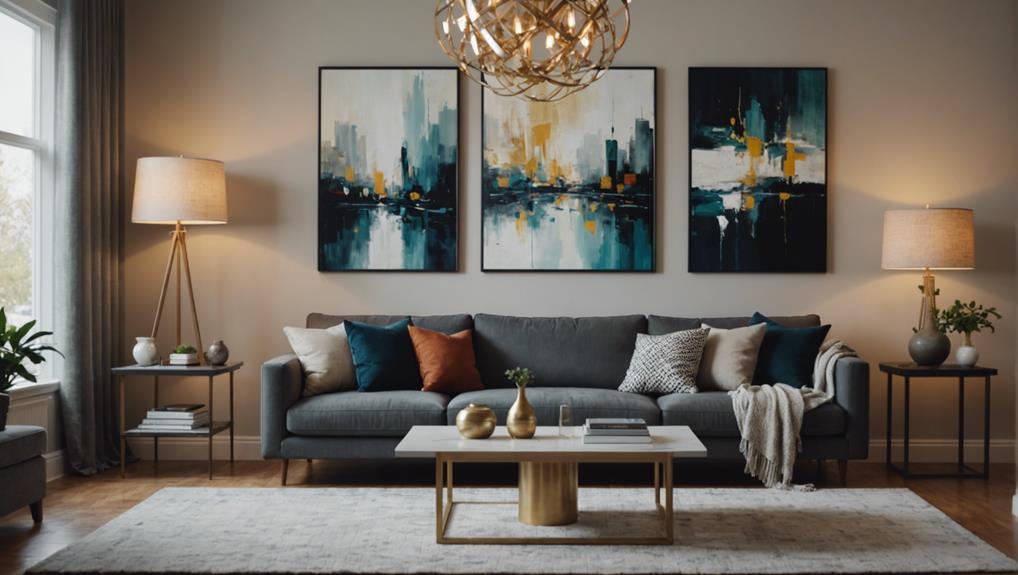
Enhance your living space with home decor art, which includes paintings, prints, photographs, and tapestries. These artistic pieces play a crucial role in defining your home's aesthetic appeal, infusing personal style and taste into the environment. They serve as focal points, adding visual interest, depth, and personality to rooms. They range from vibrant modern styles to classic artworks, allowing you to express individuality and create a unique ambiance in your home. Home decor art contributes significantly to creating a dynamic and personalized look that elevates your overall decor by incorporating different types of wall art like canvas prints and metal art.
Key Takeaways
- Home Decor Art enhances living spaces with aesthetic appeal.
- Wall art, such as paintings and prints, serves as focal points.
- Allows expression of individuality and creation of unique ambiance.
- Plays a pivotal role in defining the aesthetic appeal of a home.
- Infuses personal style and taste, transforming spaces with harmony.
Definition of Home Decor Art

In home decor art, the focus is on artistic pieces specifically crafted to enhance the aesthetic appeal of living spaces. Wall art is a key component of home decor art, encompassing a wide array of pieces such as paintings, prints, photographs, and tapestries designed to adorn and beautify walls. These pieces serve as focal points in a room, adding visual interest, depth, and personality to the space.
Wall art can range from vibrant and bold modern pieces to more traditional and classic artworks, catering to diverse tastes and interior design styles. Whether you prefer abstract paintings, nature-inspired prints, or vintage photographs, wall art allows you to express your individuality and create a unique ambiance in your home.
Importance of Home Decor Art
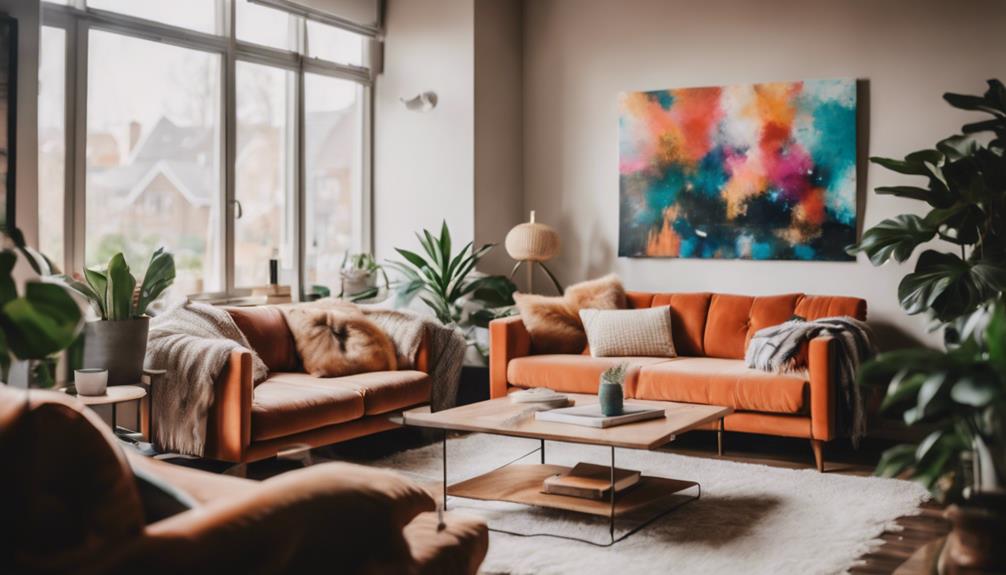
Enhancing the ambiance and character of your living space, home decor art plays a pivotal role in defining the aesthetic appeal of your home. By incorporating carefully selected art pieces, you have the opportunity to infuse your personal style and taste into your living environment.
Quality home decor art can bring harmony and visual interest to a room, transforming it into a welcoming and inviting space. The investment in home decor art goes beyond mere decoration; it's a reflection of your personality and can set the tone for a warm atmosphere that greets both you and your guests.
The importance of home decor art lies in its ability to add unique accents, create a sense of cohesion, and elevate the overall look and feel of your home. Choosing the right pieces can truly make a difference in how your living space is perceived and experienced.
Types of Home Decor Art
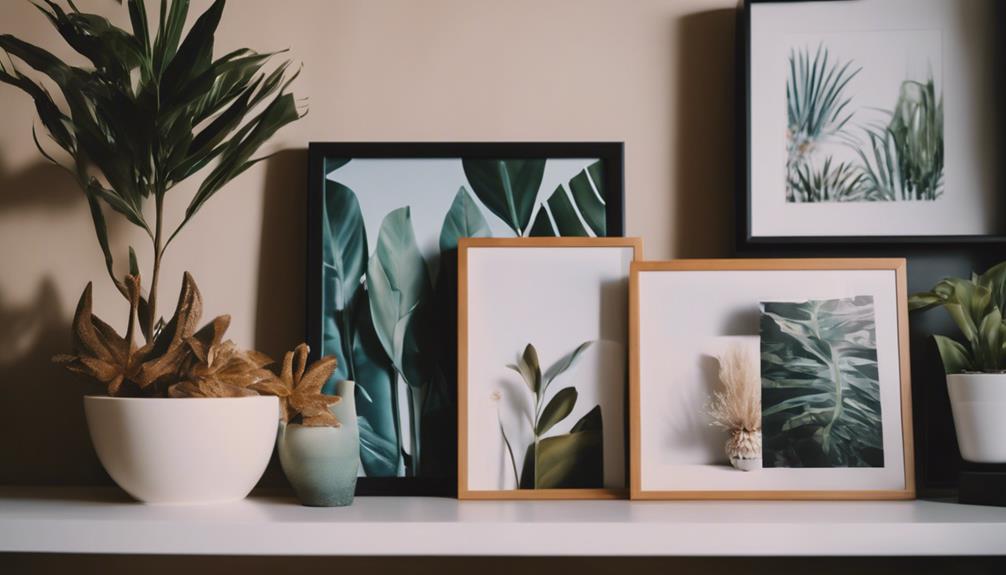
When exploring types of home decor art, you'll encounter various styles of wall art, DIY decor projects, and art placement tips. These elements play an important role in enhancing your living spaces, allowing you to express your unique style and personality.
Whether you prefer classic paintings or modern sculptures, there are options to cater to every taste and aesthetic preference.
Styles of Wall Art
Canvas prints, metal wall art, digital downloads, sculptures, and figurines are popular styles of wall art for home decor.
- Canvas prints offer a traditional and versatile option for decorating walls with various artistic designs.
- Metal wall art provides a modern and unique touch to home decor, often featuring intricate and contemporary designs.
- Digital art downloads offer a convenient and cost-effective way to access a wide range of art pieces for decorating spaces.
- Sculptures and figurines add a three-dimensional element to home decor, showcasing artistry and craftsmanship in various forms.
DIY Decor Projects
To explore the domain of DIY decor projects in the world of home decor art, you can express your creativity through a multitude of hands-on endeavors. DIY decor projects encompass a wide range of artistic expressions, such as creating wall art, crafting unique sculptures, designing custom furniture pieces, and making personalized accents.
These projects provide a platform for you to infuse your living spaces with personalized art that reflects your unique style and personality. By engaging in DIY decor, you have the opportunity to repurpose materials, upcycle old items, and showcase your artistic flair.
Not only is it a fulfilling experience, but it's also a cost-effective way to enhance your home with one-of-a-kind art pieces that truly resonate with you.
Art Placement Tips
For ideal display of home decor art, consider the size, theme, and color scheme of the artwork in relation to your room's design. When it comes to wall decor, follow these tips for art placement:
- Size Matters: Larger pieces work best on prominent walls to make a bold statement.
- Grouping for Impact: Create a gallery wall effect by grouping smaller artworks together for added interest.
- Mix and Match: Combine different types of wall decor like metal art, sculptures, and digital downloads for a dynamic look.
- Theme and Harmony: Make sure the art complements the overall theme and color scheme of the room to create a cohesive and visually appealing space.
Incorporating Home Decor Art
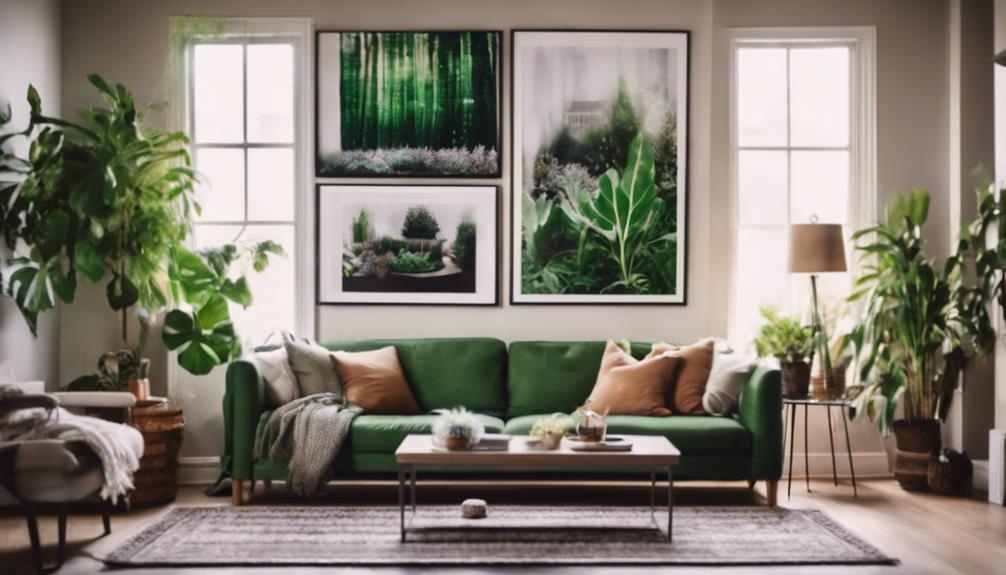
Enhance your living space with a touch of personality and style by incorporating home decor art. Wall art is a popular choice for adding visual interest and character to your home. Consider mixing different types of wall art, such as canvas prints, metal art, or digital downloads, to create a dynamic and personalized look. Here is a simple guide to help you incorporate home decor art effectively:
| Types of Home Decor Art | Description | Benefits |
|---|---|---|
| Canvas Prints | Printed on canvas | Versatile and customizable |
| Metal Wall Art | Sculptures or images | Adds depth and texture |
| Digital Art Downloads | Downloadable artworks | Easy to change and update |
Trends in Home Decor Art
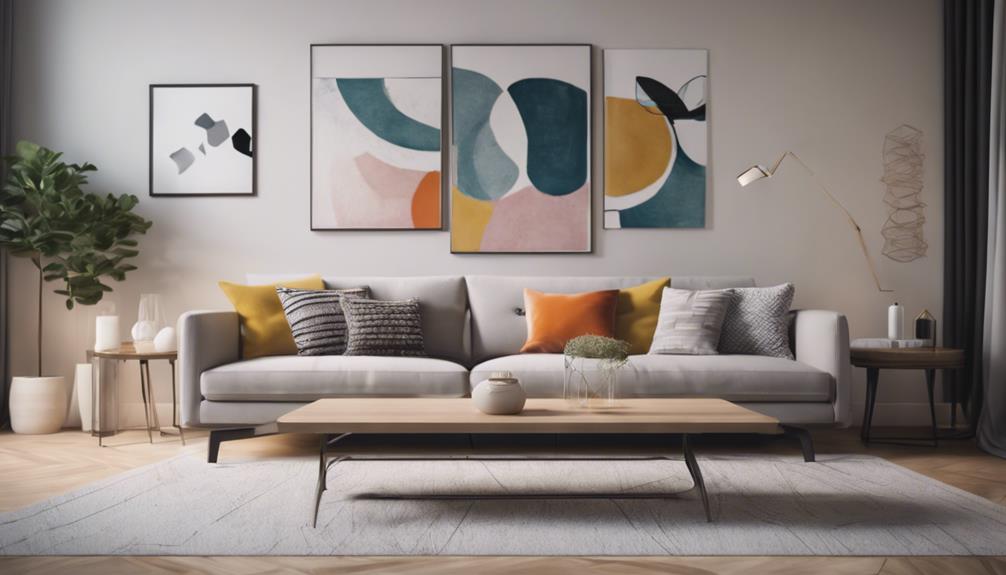
Discover the latest trends in home decor art, from minimalist wall art to abstract sculptures and botanical prints.
Sustainable materials are gaining popularity, reflecting a shift towards eco-conscious design choices.
Personalized pieces like family portraits and custom quotes are also on the rise, adding a touch of individuality to home decor.
Popular Art Styles
When exploring popular art styles in home decor, you'll find a diverse range including minimalist, bohemian, Scandinavian, farmhouse, and mid-century modern designs. These styles offer a mix of simplicity, eclectic flair, clean lines, rustic charm, and retro vibes for your living space.
Each style brings a unique aesthetic that can be personalized to suit your taste and complement your home's ambiance. Whether you prefer a sleek and understated look or a cozy and vibrant atmosphere, there's an art style to match your vision.
Incorporating original artwork into these styles can elevate the decor, adding a touch of individuality and creativity to your living space. Let your walls reflect your personality with these popular art styles.
Emerging Design Trends
Amidst the ever-evolving landscape of home decor art, emerging design trends are reshaping the way we adorn our living spaces.
Maximalist gallery wall sets have gained popularity, offering over 3000 pieces at a 75% discount.
Digital art downloads are on the rise, with bundles of 1000+ printable vintage art prints available for 75% off.
Metal wall art, like the Guernica Pablo Picasso design, is in demand, with a 40% discount on unique modern home decor items.
Sculptures and figurines, such as bronze animal figurines like a deer head, are trending at a 72% discount.
Luxury golden seascape artwork is a popular choice, with 405 pieces sold at a 50% discount, including free shipping for added value.
Buying Home Decor Art
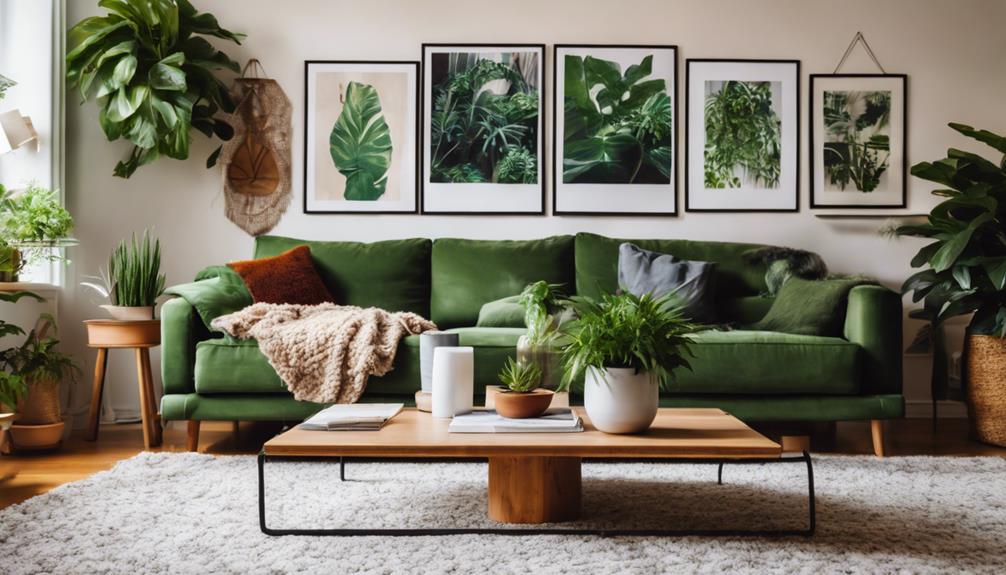
In the world of home decor art, your quest for the perfect pieces to adorn your living space begins with exploring various options that suit your style and budget. When buying home decor art, consider these key points:
- Diverse Selection: Home decor art encompasses a wide range of items, from wall art prints to sculptures, ensuring you find something that resonates with your taste.
- Affordable Deals: Look out for sales, discounts, and free shipping offers that can make purchasing home decor art more budget-friendly.
- Convenience of Digital Art: Digital art downloads provide a cost-effective way to enhance your decor with printable vintage art prints and gallery wall sets.
- Elegant Choices: Bronze animal figurines and wood wall decor are popular for adding a touch of sophistication to your home decor.
Frequently Asked Questions
What Is Considered Home Decor?
When it comes to home decor, a wide variety of items fall under this category. From wall art to sculptures, figurines, and decorative accents, these pieces are designed to enhance the aesthetic appeal of your living spaces.
They can cater to different tastes and preferences, offering affordable options for adding personality and charm to your interiors.
What Is Decor in Art?
Decor in art encompasses mass-produced items like prints, posters, and replicas designed for decorative purposes rather than artistic expression. These pieces are accessible and affordable, enhancing the aesthetic appeal of a space without the artist's personal touch.
The category includes various products such as wall art, sculptures, figurines, and framed prints. Decor in art serves to beautify surroundings with commercially produced pieces rather than original artworks.
What Is the Best Description of Home Decor?
When it comes to describing home decor, think of it as the art of enhancing your living space with decorative pieces. These items, such as wall art, sculptures, and figurines, are designed to add aesthetic appeal to your home.
What Is an Example of Decorative Art?
When looking for an example of decorative art, think of items like:
- Wall decals
- Framed prints
- Art reproductions
These pieces are often mass-produced and designed to enhance the look of a space without conveying the artist's personal expression. While decorative art can beautify a room, it lacks the unique energy and authenticity of original, handcrafted artwork.
Consider these commercial pieces for adding aesthetic appeal to your home decor.
Conclusion
To sum up, home decor art plays a significant role in enhancing the aesthetic appeal and ambiance of any living space. With various types and trends to choose from, incorporating home decor art can truly transform a house into a home. Whether you prefer modern minimalism or classic elegance, finding the perfect pieces to reflect your style is key.
Stay tuned for more tips and inspiration on how to elevate your home decor with art.
Home Decor
5 Stunning Navy Accent Wall Ideas
Hues of sophistication await as navy accent walls transform spaces into cozy retreats, dramatic focal points, and modern masterpieces.
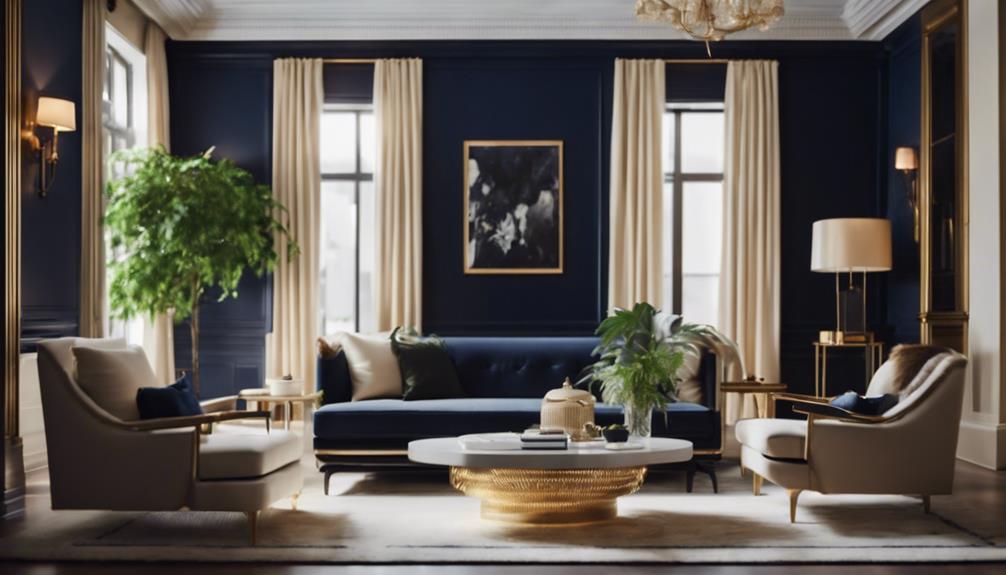
You're about to discover the dramatic impact a navy accent wall can have on a room! From elevating the atmosphere to creating a sense of sophistication, a single wall can make a world of difference. In modern spaces, navy walls layer beautifully with textures and metallic accents. In living rooms, they create a cozy atmosphere when paired with white furniture. In bedrooms, they create a serene retreat. Navy walls can even define specific areas within a room or create a striking focal point. As you explore these stunning ideas, you'll uncover the versatility and beauty of navy accent walls in various settings.
Key Takeaways
• A navy accent wall elevates the atmosphere of a modern space when paired with clean-lined furniture and layered textures.
• In living rooms, a navy accent wall creates a cozy atmosphere, especially when paired with white furniture and metallic accents for contrast and sophistication.
• In bedrooms, a navy accent wall creates a cozy retreat when paired with a blue headboard and considered design style pairing for a desired mood.
• A navy accent wall creates a striking focal point in any room, adding depth and visual interest, especially when used as a feature wall behind a gallery.
• Outdoor spaces can be elevated with a navy accent wall, which complements natural surroundings and withstands outdoor elements, creating a stylish oasis.
Navy Blue in Modern Spaces
In your modern space, a navy accent wall can instantly elevate the atmosphere, transforming it into a sophisticated and modern oasis. By incorporating modern furniture with clean lines and minimal ornamentation, you can create a cohesive look that exudes refinement.
To add depth and visual interest, try layering textures against the navy accent wall, such as velvet, linen, or reclaimed wood. Metallic accents in gold or silver can add a luxurious touch, while complementary colors like warm mustard can create dynamic contrast.
For a crisp and tranquil vibe, incorporate pops of white through accessories or furniture with clean lines. A navy accent wall can also provide a sophisticated backdrop for statement pieces, allowing them to take center stage.
Bold Accent Walls in Living
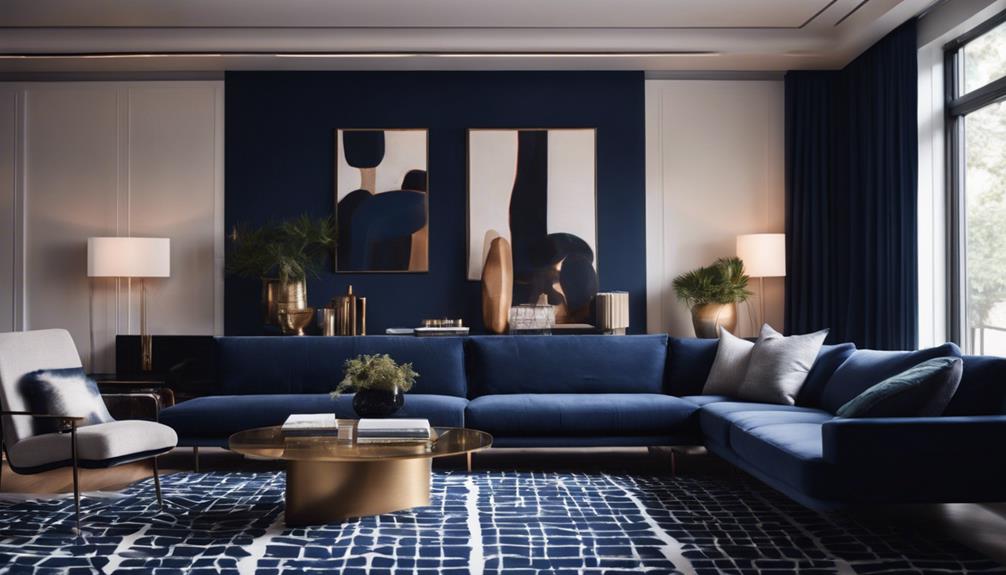
One bold way to redefine your living space is by introducing a navy accent wall that creates a cozy yet dramatic atmosphere. This moody blue wall sets an elegant tone for a stylish ambiance, making it ideal for home theaters or game rooms to enhance the overall aesthetic.
Here are some ideas to get you started:
- Pair navy walls with white furniture for a dramatic contrast in living spaces
- Add metallic accents for a modern look that exudes sophistication
- Create a cozy nook with navy walls and plush furniture for a relaxing atmosphere
- Use navy walls to create a focal point in your living room, drawing attention to a statement piece of art or furniture
- Balance navy walls with lighter-colored flooring to prevent the space from feeling too dark or overwhelming
Navy Accent Walls in Bedrooms
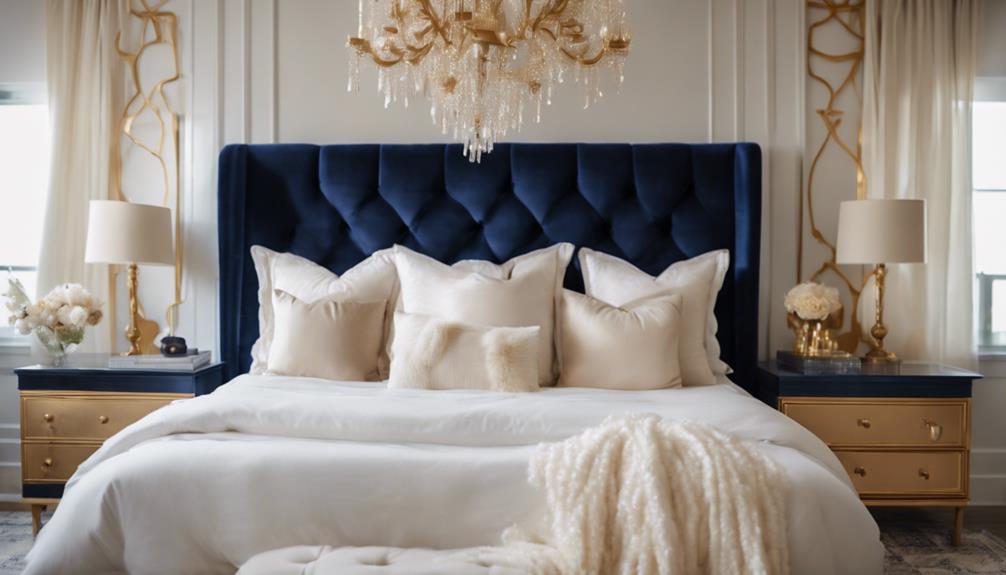
Transforming your bedroom into a serene retreat, navy accent walls create a cozy and stylish atmosphere that envelops you in relaxation, making it the perfect sanctuary to unwind after a long day. By incorporating a navy accent wall, you can create a calming and inviting space that promotes rest and rejuvenation. To elevate the ambiance, pair your navy accent wall with a blue headboard and floral bedding for an elegant touch.
| Design Style | Navy Accent Wall Pairing |
|---|---|
| Modern | Dark grey walls for a sophisticated ambiance |
| Farmhouse | Rustic wooden furniture for a cozy feel |
| Coastal | Light blue accents for a calming atmosphere |
| Traditional | Rich wood tones for a luxurious look |
When choosing the perfect navy shade for your bedroom, consider the overall mood you want to create. A darker, richer navy can evoke a sense of luxury, while a lighter, softer navy can create a calming atmosphere. Whatever your style, a navy accent wall can add a touch of sophistication and serenity to your bedroom oasis.
Creating Focal Points With Navy
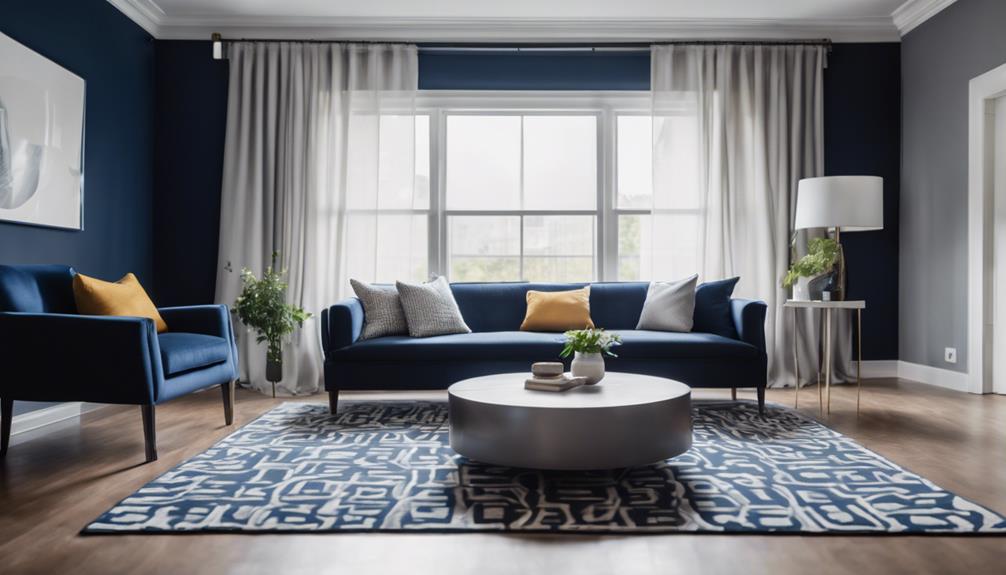
By strategically placing a navy accent wall, you can create a striking focal point that draws the eye and adds depth to the space. This bold design element can transform any room, making it a great way to add visual interest to your dining room or living area.
Here are some ideas to get you started:
- Use a navy blue wall as a feature wall behind a gallery wall, creating a striking backdrop for your favorite artwork or photos.
- Paint a single wall in a deep navy blue to create a bold accent wall that anchors the space.
- Incorporate a navy accent wall to define a specific area within a room, such as a cozy reading nook or a dining space.
- Create a sense of balance and contrast by pairing a navy accent wall with lighter-colored furniture and decor.
- Use a navy accent wall to create a cohesive design scheme throughout your home, tying together different rooms and spaces.
Dramatic Navy Accent Walls Outdoor
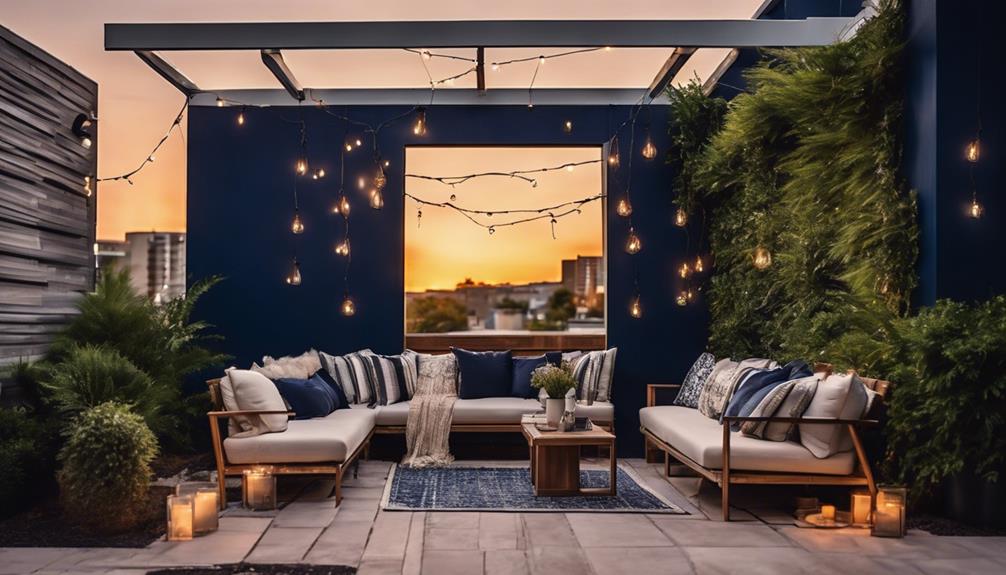
You can take your navy accent wall design outdoors to create a dramatic statement that elevates your patio, porch, or outdoor seating area. By pairing navy accent walls with white or light-colored accents, you'll add depth and sophistication to your outdoor space. This bold and stylish look complements natural surroundings, creating a cohesive and inviting atmosphere for entertaining or relaxing.
Here are some ideas to get you started:
| Navy Accent Wall | Accents | Furniture |
|---|---|---|
| Dark navy blue | White walls, potted plants | Leather sofa, side tables |
| Soft navy blue | Light gray walls, natural textures | Wicker armchair, wooden benches |
| Midnight blue | Creamy white walls, metallic accents | Sectional sofa, concrete coffee table |
| Royal blue | Soft gray walls, lush greenery | Vintage armchair, stone side tables |
Using navy for outdoor accent walls can withstand outdoor elements and provide a striking backdrop for outdoor furniture and decor. Choose the perfect paint to create a cohesive look that complements your outdoor space. With a little creativity, you can create an outdoor oasis that's both stylish and inviting.
Frequently Asked Questions
What Color Goes Best With a Navy Accent Wall?
When selecting a color to pair with a navy accent wall, you'll want to contemplate options that provide contrast and harmony.
You'll find that neutral shades like white, grey, and beige create a sophisticated look, while bolder options like mustard yellow and coral add a dynamic touch.
Metallic accents like gold can also add a luxurious feel.
Ultimately, the right color for you'll depend on the atmosphere you want to create in the room.
What Is the Complementary Color of Navy?
You're on a mission to uncover the perfect pairing for your navy accent wall, and it starts with understanding the complementary color.
Imagine a sunny day at the beach, where the warm sand meets the cool ocean breeze – that's the contrast you'll get when you combine navy with its complementary color, a vibrant mustard yellow.
This dynamic duo creates a visually appealing contrast, making each other pop like fireworks on a summer night.
How to Decorate a Navy Blue Wall?
When decorating a navy blue wall, you can create a cozy ambiance by incorporating metallic accents. This adds a touch of sophistication and modernity. To add contrast, pair the navy wall with warm mustard cushions or experiment with bold patterns and vibrant wallpapers.
You can also utilize vertical space by installing towering bookshelves. This enhances the aesthetic appeal and provides additional storage options.
How Do You Make a Stunning Accent Wall?
To create a stunning accent wall, you'll want to start by choosing a bold, contrasting color that complements the room's overall aesthetic. Consider the natural light, furniture, and decor when making your selection.
Next, decide on the accent wall's size and placement, taking into account the room's architectural features.
Conclusion
You've explored the domain of navy accent walls, and it's time to put your newfound inspiration into action. With these stunning ideas, you'll be well on your way to creating a dramatic, sophisticated space that's uniquely yours.
Whether you're looking to make a bold statement or add a touch of elegance, navy accent walls are sure to impress. So, take the plunge and immerse yourself in the world of navy – your walls (and your sense of style) will thank you.
Vivienne – Your Content Companion Vivienne is your content companion, curating valuable tips, advice, and inspiration to guide you on your home decor journey. From insightful blog posts to informative product descriptions, she’s here to empower you with the knowledge you need to create your dream space.
Home Decor
Easy Spring Time Terrariums: 7 Simple Steps
Nurturing a mini indoor garden has never been easier, but what are the essential steps to creating a thriving spring terrarium?
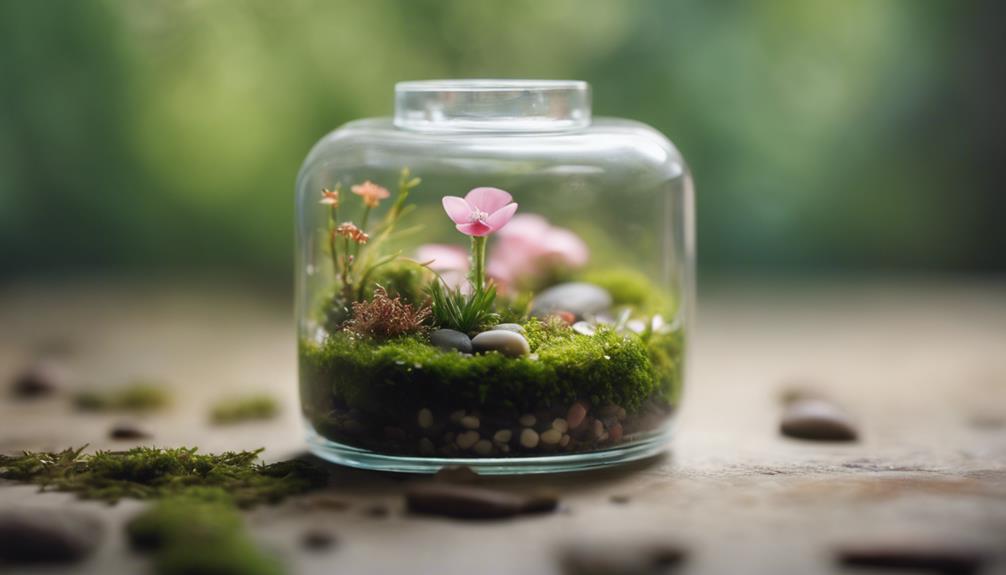
We can create a stunning spring-themed terrarium in just 7 simple steps! First, we gather essential materials like a clear glass container, pea gravel, and sphagnum moss. Then, we establish a drainage layer base, add activated charcoal for filtration, and layer sphagnum moss and soil. Next, we plant our chosen spring greens, adding decorative elements and touches. Finally, we maintain and care for our terrarium. By following these steps, we'll be enjoying our beautiful, low-maintenance mini indoor garden in no time. To guarantee our terrarium thrives, let's explore the finer details of plant selection, lighting, and humidity control.
Key Takeaways
• Choose a clear glass container and layer gravel, charcoal, and soil for proper drainage and filtration.
• Select small, slow-growing spring plants like ferns or moss that thrive in low-light conditions.
• Add decorative elements like small figurines, stones, or dried flowers to reflect your personal style.
• Place the terrarium in indirect sunlight and rotate it regularly for even growth and to prevent plant burns.
• Monitor plant growth and adjust lighting as needed, cleaning the container glass with a soft brush as necessary.
Gather Essential Terrarium Materials
We'll start by collecting the essential materials needed to create our spring time terrarium.
For this, we'll need a clear glass container, which will serve as the base of our miniature garden.
Next, we'll gather pea gravel or polished rocks, which will help with drainage and add visual appeal.
Vital charcoal is another critical component, as it will absorb excess moisture and prevent mold growth.
We'll also need sphagnum moss, a type of peat moss that retains moisture but drains excess water, making it perfect for our terrarium.
To end, we'll select small, slow-growing plants that thrive in low-light conditions, such as ferns, mosses, or air plants. It's important to choose plants that are compatible with the terrarium environment to ensure their survival.
With all our materials in hand, we can begin assembling our spring time terrarium, creating a beautiful and self-sustaining miniature ecosystem.
Create a Drainage Layer Base
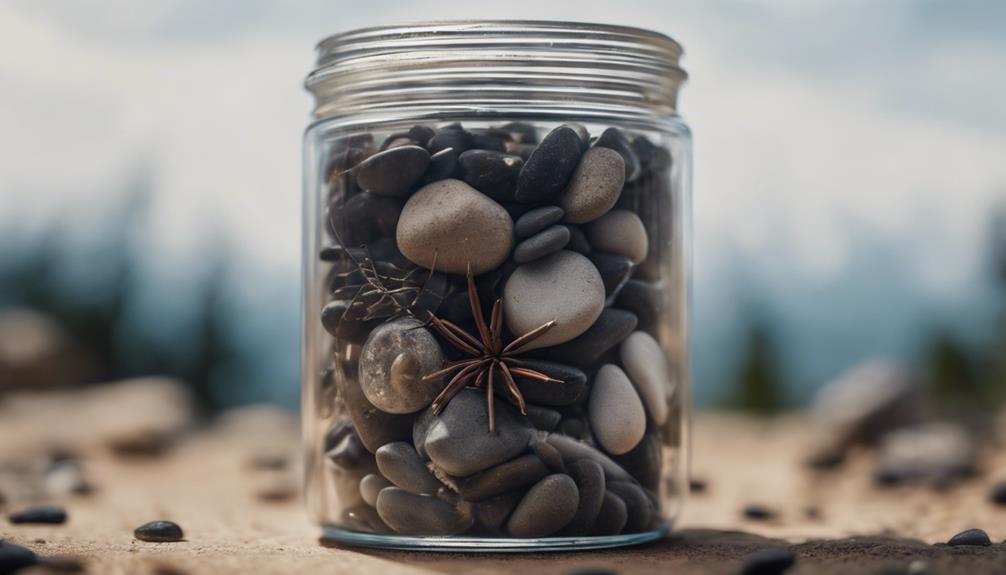
Now that we've gathered all the necessary materials, let's create a solid foundation for our springtime terrarium by building a drainage layer base that will promote healthy plant growth.
This layer is vital for preventing waterlogging and ensuring proper drainage, which is essential for a healthy environment. We'll start by adding a layer of pebbles or rocks at the bottom of our terrarium. This will allow excess water to drain through, preventing the buildup of stagnant water that can be detrimental to our plants.
Next, we'll add a layer of charcoal, which will help filter the water and prevent any unpleasant odors from developing in our terrarium. After the charcoal layer, we'll add a layer of sphagnum moss, which will act as a barrier, keeping the soil separate from the drainage materials.
Add Activated Charcoal for Filteration
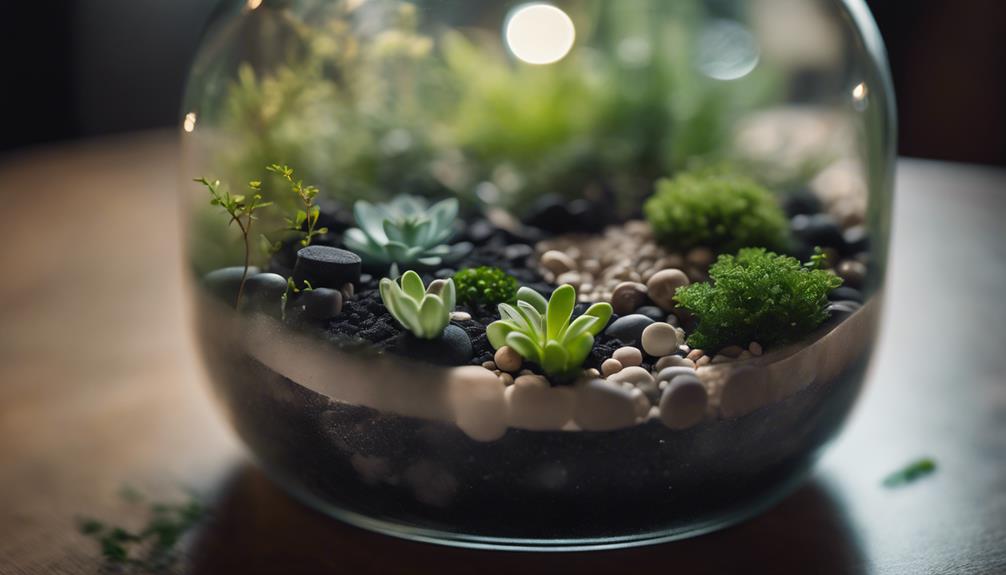
By incorporating a layer of activated charcoal into our terrarium, we're taking an essential step in maintaining a healthy and balanced environment, as it effectively filters impurities and odors. This vital layer prevents the growth of bacteria and mold by absorbing excess moisture, ensuring our plants thrive in a clean and nurturing space.
Here are three key benefits of adding activated charcoal to our terrarium:
- Improved air circulation: Activated charcoal promotes air circulation by allowing oxygen to flow freely, preventing stagnant air pockets that can harm our plants.
- Enhanced water drainage: The porous nature of activated charcoal enhances water drainage, reducing the risk of waterlogged soil and root rot.
- Optimized nutrient absorption: Activated charcoal's porous structure also facilitates the absorption of essential nutrients, giving our plants the nutrients they need to flourish.
Layer Sphagnum Moss and Soil
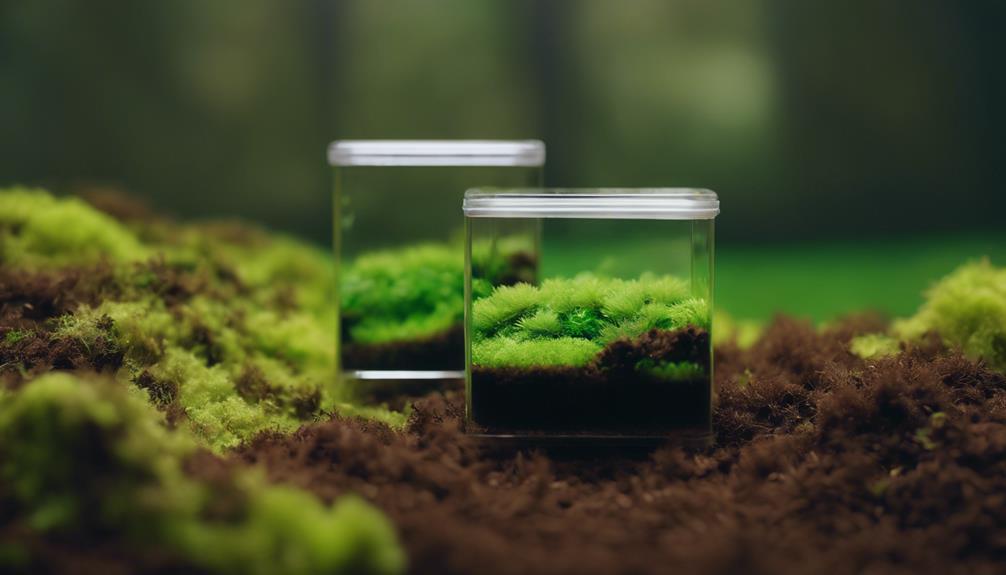
As we proceed with our Spring Time Terrariums, we're now going to tackle the essential step of layering sphagnum moss and soil.
We'll start by preparing the moss base, ensuring it's evenly distributed and ready to support our plants.
Next, we'll explore various soil layering techniques that will help create a thriving environment for our plants to grow.
Moss Base Preparation
We begin by preparing the moss base, a crucial step in creating a thriving terrarium ecosystem, by layering sphagnum moss at the bottom of the container. This moss layer acts as a moisture barrier, preventing soil from falling through and maintaining moisture within the terrarium, creating a suitable environment for plant growth. The moss layer also adds a natural and aesthetic element to the terrarium design.
Here are the key benefits of a well-prepared moss base:
- Moisture retention: Sphagnum moss helps maintain a consistent level of moisture, ensuring a healthy ecosystem.
- Soil retention: The moss layer prevents soil from falling through, keeping the terrarium design intact.
- Even spread: A uniform layer of moss ensures a balanced environment for plant growth.
Soil Layering Techniques
Now that we've prepared the moss base, let's move on to layering the soil, where we'll combine sphagnum moss and soil to create an ideal environment for our terrarium plants to thrive.
We'll start by adding a thin layer of sphagnum moss, which acts as a barrier between the soil and drainage materials, promoting proper plant growth. This natural material helps prevent soil compaction, aids in water distribution, and maintains soil moisture.
Next, we'll add a layer of activated charcoal to help with moisture control and prevent mold growth. Then, we'll add the soil around the plants, making sure not to pack it too tightly.
After that, we'll add another layer of sheet moss to help with drainage and air circulation. Since our terrarium plants don't need a lot of water, we'll make sure to leave some space between the soil and the top of the container for drainage holes.
Plant Your Chosen Spring Greens
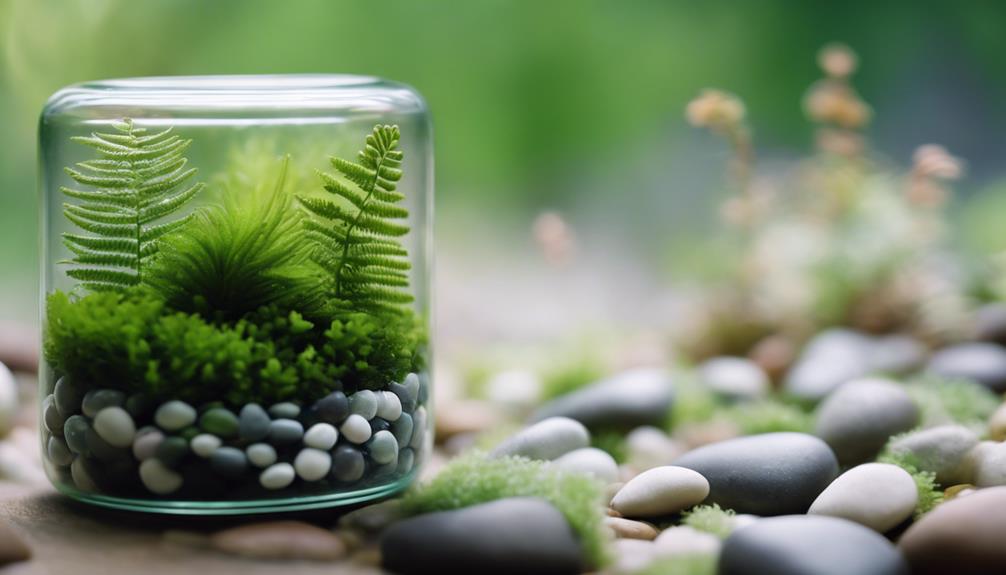
Let's get started with planting our chosen spring greens by selecting a few of our favorite species that fit our terrarium's conditions. We'll choose plants that thrive in higher humidity and indirect sunlight during the spring season, such as ferns, mosses, and ivy.
Here are some tips to keep in mind:
- Proper Plant Spacing: Make sure to leave enough space between each plant to allow for growth and visual appeal.
- Handle with Care: Gently remove the plants from their pots and tease out the roots before placing them in the terrarium.
- Water Wisely: Water the plants gently but thoroughly, making sure the potting mix is moist but not waterlogged.
As we pot our plants, we'll make sure to handle them carefully to avoid damaging their roots or leaves. We'll also use a small amount of potting mix specifically designed for terrariums, which will help retain moisture and prevent waterlogged soil. By following these simple steps, we'll create a beautiful and thriving spring terrarium that will bring joy and serenity to our space.
Add Decorative Elements and Touches
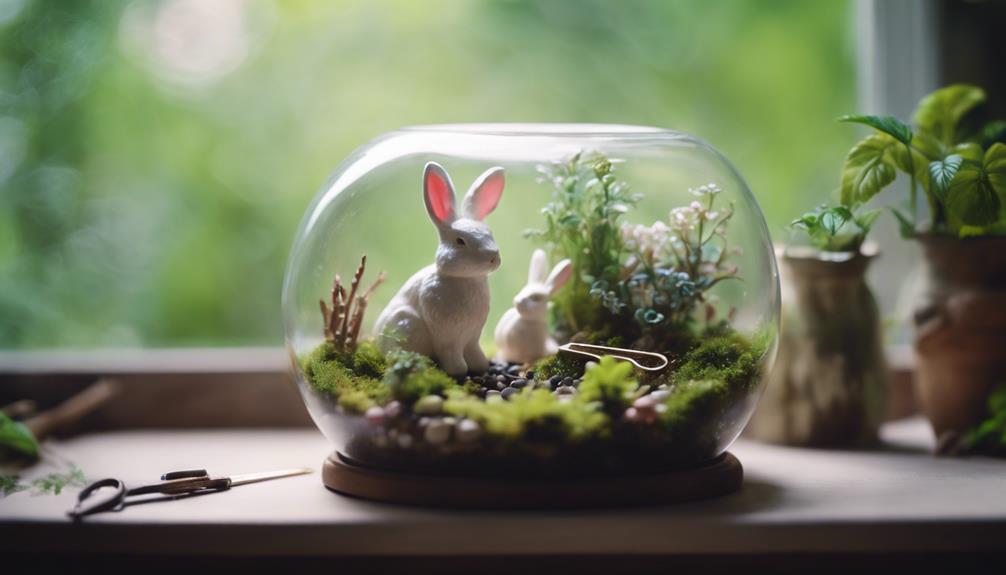
With our plants securely in place, we're ready to add the finishing touches to our spring terrarium by incorporating decorative elements that reflect our personal style.
It's time to get creative and add decorative elements that bring our terrarium to life. We can add small figurines, miniatures, or tiny accessories to personalize our terrarium and give it a unique touch.
Colored stones, crystals, or seashells can enhance the visual appeal of our terrarium, while natural elements like dried flowers, pinecones, or driftwood can add a rustic charm. We can experiment with different textures and colors to create a visually interesting and harmonious display.
For a whimsical touch, we can use miniature fairy garden items or tiny animals to create a magical terrarium theme. By adding these decorative elements, we can transform our terrarium into a beautiful and unique piece of art that reflects our personality.
Maintain and Care for Your Terrarium
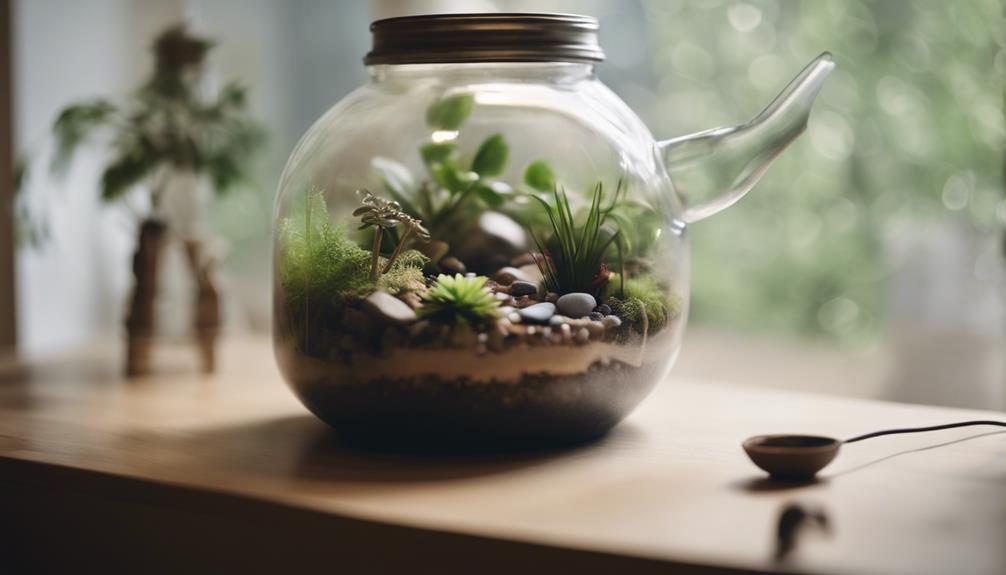
As we move forward with our terrariums, we'll need to focus on maintaining and caring for them. We'll explore the best practices for watering, including scheduling tips and humidity control methods, to guarantee our miniature gardens thrive.
Watering Schedule Tips
We water our terrariums just enough to maintain the delicate balance of moisture, knowing that overwatering can be detrimental to the health of our plants. To guarantee our plants thrive, we follow a few simple watering schedule tips.
Here are some guidelines to keep in mind:
- Watering frequency: For open terrariums, we water once a week or when the soil feels dry to the touch. Closed terrariums require watering every 4-6 months to maintain moisture levels.
- Drainage is key: We add drainage to our glass jar to prevent waterlogged soil, which can lead to root rot and other problems.
- Monitor and adjust: We regularly check the condition of the soil and plants in our terrarium, adjusting our watering frequency as needed. We also remove any yellowing or damaged leaves and clean the container glass periodically to maintain a clear view of our terrarium.
Humidity Control Methods
By maintaining ideal humidity levels, we create an environment where our plants can thrive, and now it's time to explore the methods for controlling humidity in our terrariums.
A closed terrarium is an excellent way to naturally regulate humidity levels, especially for tropical plants. However, it's important to make sure proper ventilation to prevent mold growth due to excess moisture. We can monitor condensation levels on the terrarium walls as an indicator of humidity control effectiveness.
For open terrariums, we need to water more frequently to maintain adequate moisture levels for plant health. To improve air circulation and prevent stagnant humidity buildup, we can consider adding a small fan near the terrarium. Another trick is to add activated charcoal on top of the potting mix to absorb excess moisture.
Frequently Asked Questions
How to Make a Terrarium Step by Step?
We're thrilled to immerse ourselves in creating a mini indoor garden!
To make a terrarium, we'll start by selecting a clear container without drainage holes. Then, we'll layer in pea gravel, activated charcoal, sphagnum moss, and potting soil for proper drainage and plant growth.
Next, we'll carefully plant our selected plants, followed by adding decorative elements for visual appeal.
What Goes First in a Terrarium?
As we start on our terrarium journey, the first vital step is to establish a solid foundation.
So, what goes first in a terrarium? The answer lies in the humble beginnings of gravel or pebbles.
This initial layer provides essential drainage, preventing waterlogged soil and ensuring our miniature ecosystem thrives.
How Do You Make a Simple Terrarium for Kids?
We make a simple terrarium for kids by choosing a clear plastic container and adding a layer of gravel for drainage.
Next, we add a thin layer of charcoal to prevent mold growth, followed by a layer of soil.
We plant hardy succulents or air plants, and let kids get creative with colorful pebbles, figurines, or miniatures.
How Do You Make a Low Maintenance Terrarium?
We're excited to share that 75% of indoor plants are now low-maintenance terrariums! To make one, we choose plants like air plants, succulents, and miniature ferns that thrive in low light and humid conditions.
We avoid overwatering by monitoring soil moisture and only watering when necessary. We place our terrariums in indirect sunlight to prevent burning or drying out.
Conclusion
We've successfully created our own mini springtime world in a glass container!
To illustrate, let's take the example of Emma, who crafted a beautiful terrarium with baby's tears and ferns. She placed it on her office desk, where it thrives under the fluorescent lights, requiring only occasional watering.
With these 7 simple steps, you too can bring a touch of spring into your home or workspace, enjoying the calming benefits of a self-sustaining mini-ecosystem.
Interior
Do Interior Designers Do Construction
Peering into the world of construction, interior designers weave a tapestry of design magic, elevating spaces with their creative touch.
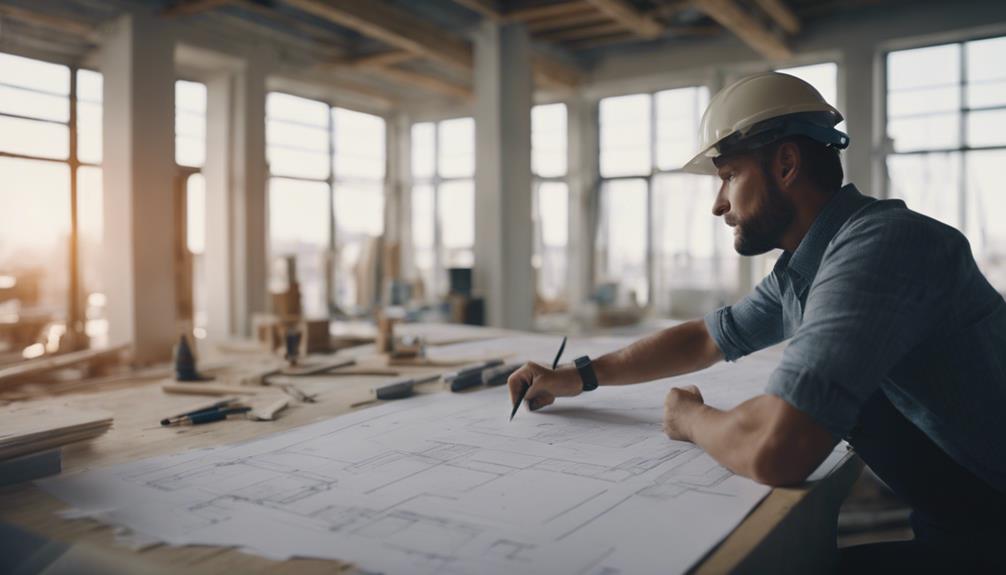
Yes, interior designers play a crucial role in construction. They focus on aesthetics, functionality, and detailed design elements to enhance the built environment. Collaborating with architects, builders, and contractors, they select materials, finishes, and lighting placements. Interior designers create personalized interior plans and 3D renderings, reducing decision-making burdens for clients. Their responsibilities include overseeing the installation of finishes, fixtures, and furnishings, ensuring projects stay on track. By working closely with construction professionals, interior designers contribute immensely to project success. Their impact on construction projects is profound, influencing design cohesion and enhancing overall project efficiency and client satisfaction.
Key Takeaways
- Interior designers oversee interior aspects within construction projects.
- They focus on aesthetics, materials, finishes, and spatial planning.
- Collaborate with architects, builders, and contractors for design cohesion.
- Ensure design plans are implemented accurately and efficiently.
- Interior designers enhance the overall look and feel of construction projects.
Interior Designers' Role in Construction
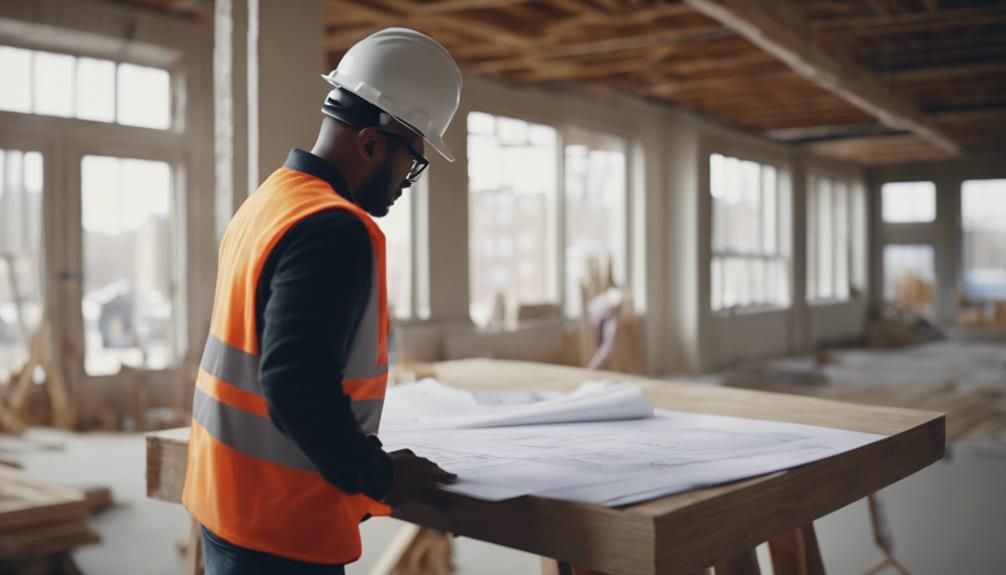
Interior designers play an essential role in construction projects by focusing on aesthetics, functionality, and detailed design elements. As an interior designer, your work goes beyond just making a space look pretty. You collaborate with architects, builders, and contractors to guarantee that the design isn't only beautiful but also practical and well-planned. Your responsibilities include selecting materials and finishes, deciding on lighting placements, and even arranging furniture to create a cohesive look.
Moreover, interior designers like yourself create personalized interior plans and 3D renderings to help clients visualize the end result. By taking on these tasks, you help reduce the decision-making burden on clients, making the process smoother and more enjoyable for them. Working closely with the construction team, you save time and money while ensuring that the client's needs and desires are met seamlessly. Your attention to detail and eye for design truly make a difference in bringing spaces to life.
Construction Collaboration With Interior Designers
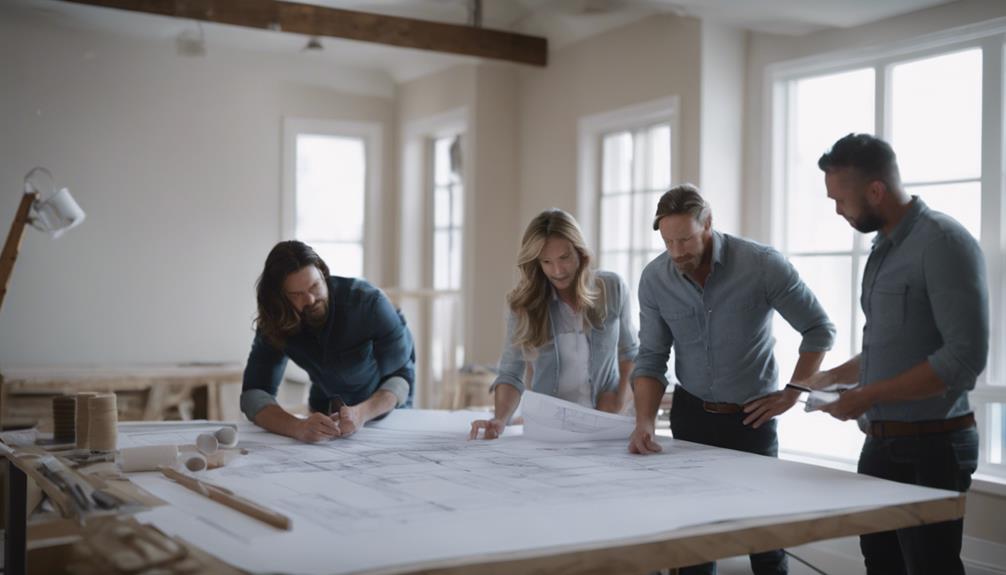
Collaborating with construction teams, designers guarantee smooth alignment between design plans and structural requirements. Interior designers play an essential role in providing detailed interior plans for construction projects, including material selections and spatial layouts. By working closely with architects, contractors, and builders, designers enhance communication and ensure project cohesion.
Early collaboration with interior designers in the construction process is key to streamlining decision-making and preventing design conflicts. These professionals manage both the aesthetic and functional aspects of construction projects, ensuring that the end result meets both design vision and practical needs. Through their expertise in interior design principles and construction knowledge, designers contribute significantly to the success of building projects.
Responsibilities of Interior Designers in Construction
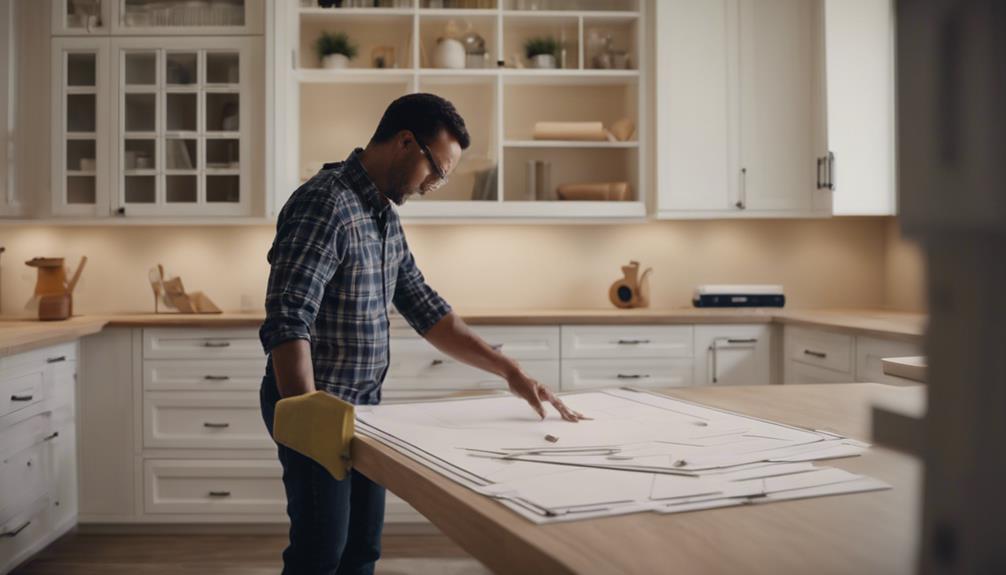
Playing an essential role in the construction process, interior designers focus on space planning, material selection, and aesthetic enhancement. They work closely with general contractors and subcontractors to make sure that the design vision is executed accurately. Interior designers oversee the installation of interior finishes, fixtures, and furnishings to bring the design concept to life. In addition to coordinating with architects and builders, they address vital aspects like lighting design, color schemes, and overall ambiance to create a harmonious and functional space.
Interior designers play a pivotal role in guaranteeing that the project stays on track and that the design intent is translated seamlessly into the built environment. Their attention to detail and creative input help elevate the overall quality of the construction project. By collaborating with the general contractor and other construction professionals, interior designers contribute significantly to the successful completion of a project that meets both aesthetic and functional requirements.
Interior Designers' Impact on Construction Projects
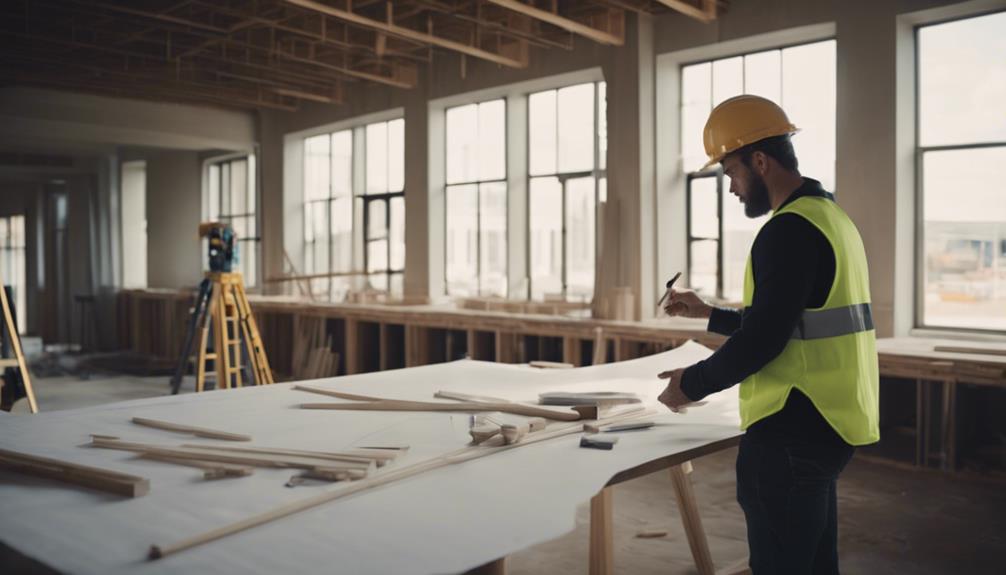
When it comes to construction projects, interior designers have a significant impact on the final result. They bring a unique design influence that enhances the aesthetic appeal and functionality of the space.
Design Influence on Construction
Interior designers wield significant influence over construction projects through their meticulous attention to aesthetics, functionality, and design cohesion. They impact the construction process by selecting materials, finishes, and design elements essential to the project.
Working closely with architects, builders, and contractors, interior designers ensure effective implementation of design plans. Their choices in lighting, furniture placement, and color schemes shape the construction outcome significantly.
Collaboration for Project Success
To guarantee the success of construction projects, interior designers prioritize collaboration with key professionals to align design visions with client preferences and streamline communication processes. By working closely with project managers, architects, contractors, and other team members, interior designers make certain that everyone is on the same page, enhancing project efficiency and client satisfaction. This collaborative effort is essential in project management to prevent delays, resolve issues promptly, and deliver high-quality results. Below is a table showcasing the key professionals that interior designers collaborate with to drive project success:
| Key Professionals | Role | Importance |
|---|---|---|
| Project Managers | Oversee the entire project | Guarantee timelines and budgets |
| Architects | Design the overall structure | Create the blueprint for construction |
| Contractors | Execute the construction work | Bring the design to life |
| Design Team Members | Contribute expertise in various design aspects | Ensure cohesive design execution |
Construction Process and Interior Designers

Throughout the construction process, interior designers play a pivotal role in guaranteeing that design plans are accurately executed by collaborating closely with construction teams. They provide detailed specifications for construction, including materials, finishes, and layout instructions. By working hand in hand with builders, interior designers ensure that the design and build aspects align seamlessly.
In addition to the technical aspects, interior designers oversee the aesthetic elements of construction, such as choosing color schemes, determining lighting placements, and finalizing furniture arrangements. Their collaboration with contractors is essential to guarantee that the construction process reflects the overall design vision effectively. Interior designers act as coordinators, ensuring that every step in the construction process contributes to a cohesive and well-executed final result.
Their attention to detail and creative input enhance the overall outcome, turning design plans into tangible, visually stunning spaces.
The Relationship Between Interior Designers and Construction

When it comes to the relationship between interior designers and construction, their collaboration is key to the success of a project.
By working closely together, designers and construction teams guarantee that the design vision is brought to life seamlessly.
This partnership allows for a harmonious blend of creativity and practicality, resulting in a well-executed final product.
Designers' Role in Construction
Interior designers play a pivotal role in construction projects by collaborating closely with architects, contractors, and builders to bring the client's vision for interior spaces to fruition. While they don't physically construct, they focus on aesthetics, functionality, and design cohesion.
Designers contribute to space planning, material selection, color schemes, lighting design, and furniture layouts. They make sure that design plans align with structural requirements, building codes, and client preferences. Their expertise in design principles and coordination with construction professionals are essential for achieving a well-executed and aesthetically pleasing end result.
Collaboration for Success
Collaborating closely with construction teams, interior designers make sure that design plans are executed accurately and efficiently. This collaboration is essential for the success of projects, ensuring that both aesthetic and functional aspects are seamlessly integrated. Here are four key ways in which interior designers and construction professionals work together for successful outcomes:
- Maintaining Communication: Interior designers work closely with contractors, architects, and builders to guarantee alignment throughout the construction process.
- Coordinating Design Elements: Designers play an important role in aligning design elements with construction requirements for a cohesive project outcome.
- Addressing Design Challenges: Their input helps in solving design challenges that may arise during construction, ensuring a smooth project progression.
- Achieving Desired Results: The relationship between interior designers and construction professionals is essential for achieving the desired results in residential and commercial projects.
Construction Execution by Interior Designers
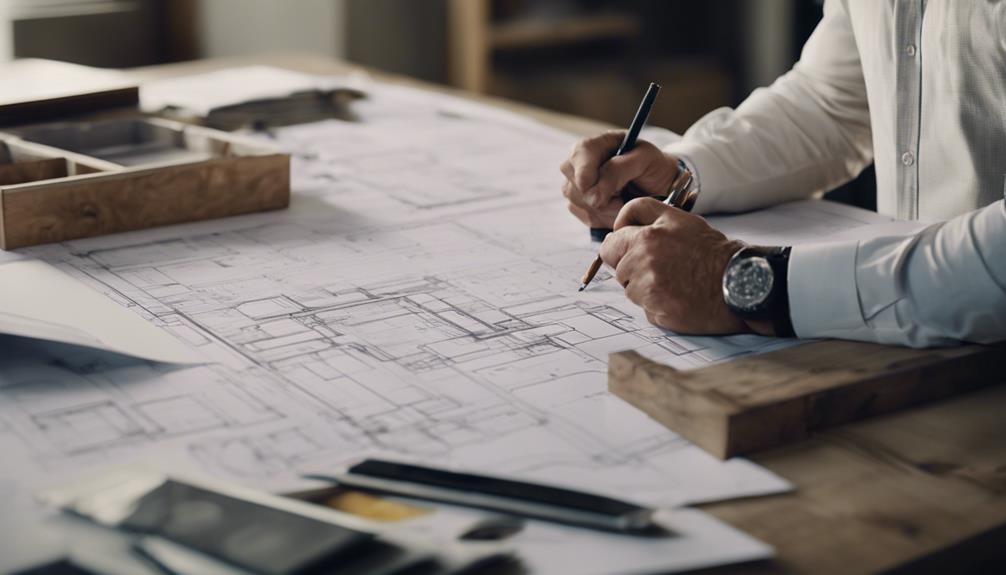
During the construction phase, interior designers actively oversee the implementation of design plans to guarantee alignment with the envisioned aesthetic and functionality of the space. Working within a design firm, they collaborate closely with contractors, builders, and tradespeople to make sure that the design vision is executed accurately and according to specifications.
Interior designers focus on the aesthetic and functional aspects of the project, supervising the selection and installation of finishes, furnishings, and fixtures to bring their design concepts to life. By managing the construction execution, interior designers play an essential role in ensuring that the final result meets the client's needs, preferences, and the overall design concept.
Their attention to detail and coordination with construction teams help create spaces that not only look visually appealing but also function effectively for their intended purposes. Interior designers bring creativity and practicality together to transform design plans into tangible, beautiful realities during the construction process.
Interior Designers' Contributions to Construction

Enhancing construction projects with their expertise in aesthetics and functionality, interior designers play an essential role in guaranteeing cohesive design implementation. When it comes to their contributions to construction projects, interior designers bring a unique set of skills to the table. Here are some ways in which they add value to the design process:
- Consideration of Aesthetics: Interior designers focus on creating visually appealing spaces that align with the client's vision while also taking into account the overall design scheme of the project.
- Functionality Planning: They make sure that the layout and design elements not only look good but also serve a practical purpose, enhancing the usability and comfort of the space.
- Collaboration with Construction Team: Interior designers work closely with architects, builders, and contractors to integrate design elements seamlessly into the construction process, ensuring a harmonious end result.
- Attention to Detail: From material selections to lighting choices and furniture placement, interior designers pay attention to every detail to elevate the overall look and feel of the construction project.
Construction Project Management by Interior Designers
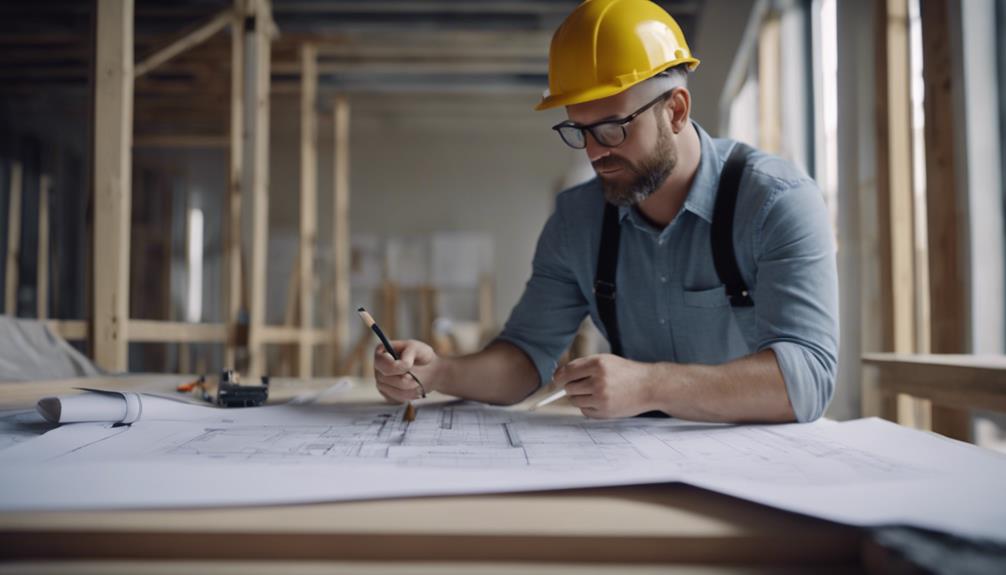
When it comes to managing construction projects, interior designers play a pivotal role in overseeing the coordination of building tasks. They guarantee that design elements are implemented seamlessly, materials are selected with care, and the overall aesthetics are maintained throughout the construction process.
Working closely with contractors and other professionals, interior designers bring their design vision to life by managing the project timeline and making critical on-site decisions.
Designers Oversee Construction
Interior designers play a pivotal role in overseeing construction projects to guarantee the accurate and efficient implementation of design visions. They manage the construction process by coordinating with contractors, architects, and other professionals involved in the project. Designers handle on-site supervision, quality control, and problem-solving to make certain the project's success. By overseeing construction, designers make sure that the design plans are executed according to specifications and within the budget. Their role in construction project management helps streamline communication, prevent delays, and maintain the overall design integrity of the project.
- Coordinate with contractors, architects, and other professionals.
- Handle on-site supervision and quality control.
- Confirm projects are within budget and specifications.
- Streamline communication and prevent delays.
Coordination of Building Tasks
In construction project management, interior designers play a pivotal role in coordinating building tasks to guarantee the seamless execution of design plans. They oversee the aesthetic and functional aspects of projects, collaborating closely with contractors, architects, and other professionals. Managing material selection, finishes, and furnishings alignment with the design plan is essential. Communication and collaboration are key, ensuring project efficiency. By providing detailed guidance on design elements and effective task coordination, interior designers streamline the construction process.
| Key Role of Interior Designers | Importance |
|---|---|
| Coordination with Contractors | Ensures design vision accuracy |
| Material Selection Management | Aligns with design plans |
| Communication and Collaboration | Maintains project efficiency |
| Task Coordination | Streamlines construction process |
Interior Designers' Influence on Construction Outcome

To optimize construction outcomes, interior designers wield significant influence through meticulous planning and precise specifications. Here are four key ways interior designers impact construction projects:
- Alignment with Client Needs: Interior designers ensure that design plans meet the specific needs and preferences of the client, enhancing overall satisfaction.
- Guiding Construction Teams: Their detailed specifications guide construction teams, reducing the need for constant client involvement in minor decisions during the project.
- Collaboration with Builders and Architects: By working closely with builders and architects, interior designers help prevent costly modifications and revisions, leading to smoother construction processes.
- Protecting Budget and Investment: Interior designers play a vital role in safeguarding the client's budget and investment by being actively involved in the drawing phase, ensuring financial considerations are met throughout the project.
Frequently Asked Questions
What Is an Interior Designer's Role in the Construction Process?
In the construction process, an interior designer plays a vital role in ensuring the aesthetic and functional aspects of a space come together harmoniously. Collaborating with architects, builders, and contractors, you focus on details like material selections, furniture layouts, and lighting design to bring the design plans to life.
Your expertise guides decision-making on design elements and spatial planning, creating personalized interiors that reflect the client's vision seamlessly.
What Is the Difference Between a Contractor and an Interior Designer?
Contractors focus on the physical construction, while interior designers emphasize aesthetics and functionality. Interior designers create cohesive design plans, select materials, and enhance the overall look and feel of a space.
Contractors handle permits, scheduling, and on-site work, while interior designers focus on color schemes, furniture layout, and lighting design. Interior designers work closely with clients to understand their needs and preferences, translating them into personalized design solutions.
What Does a Designer Do in Construction?
In construction, a designer plays a crucial role in creating cohesive design plans that blend aesthetics, functionality, and client preferences. They collaborate with architects, builders, and contractors to guarantee seamless integration of design elements.
From material selection to furniture layout, designers bring your vision to life. Their attention to detail in areas like electrical layouts and space utilization guarantees a smooth construction process.
Ultimately, designers are key players in turning ideas into reality.
Do Interior Designers Build Things?
In the world of interior design, creativity knows no bounds! Interior designers don't physically construct things, but they're the masterminds behind the magic.
Your role involves dreaming up stunning spaces, selecting materials, and working closely with construction teams to bring visions to life. From picking paint colors to choosing furniture, your design expertise shines through every detail.
Conclusion
So, next time you see a construction site, remember that interior designers play a key role in making it look fabulous. They don't just pick pretty colors and furniture; they help plan and manage the entire project from start to finish.
Without them, construction projects would lack that extra touch of style and functionality. So, give a shoutout to all the interior designers out there making our buildings look amazing!
-

 Decorative Throws2 weeks ago
Decorative Throws2 weeks agoIs It Better to Dry Clean Blankets?
-

 Yarn2 weeks ago
Yarn2 weeks agoIs Yarn Natural or Manmade? Unravel the Truth
-
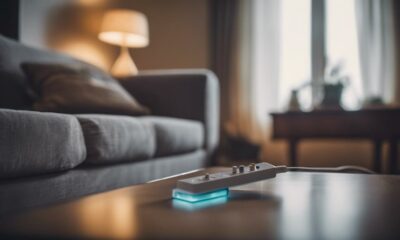
 Decorative Throws2 weeks ago
Decorative Throws2 weeks agoWhat Wattage Is an Electric Throw
-
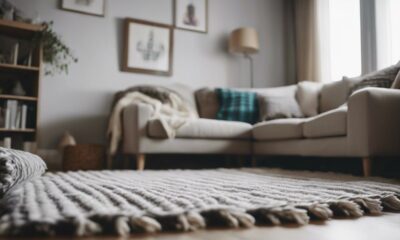
 Decorative Throws2 weeks ago
Decorative Throws2 weeks agoCan I Use a Throw Blanket as a Rug
-
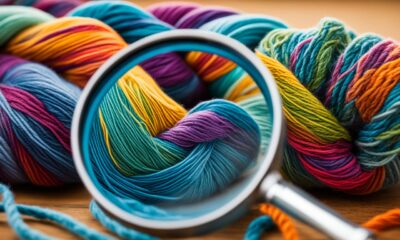
 Yarn2 weeks ago
Yarn2 weeks agoUnravel the Mystery: Why Are Yarn Specs a Secret?
-

 Craft and Textiles2 weeks ago
Craft and Textiles2 weeks ago15 Best Battery-Powered Leaf Blowers for Effortless Yard Work
-

 Tableware and Dining Accessories2 weeks ago
Tableware and Dining Accessories2 weeks agoWhat Is the Meaning of the Word Tableware
-

 Craft and Textiles2 weeks ago
Craft and Textiles2 weeks ago15 Best Toast Recipes to Start Your Day Right















